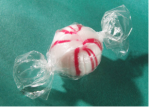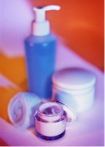 There are many substances said to prevent or relieve nipple pain and damage during the early days of breastfeeding, including lanolin, expressed breast milk and water compresses. Unfortunately, none as yet have been found to offer any real improvement over leaving nipples untreated1. Given the prevalence of the problem, however, the search for a preparation that can make early breastfeeding more comfortable continues.
There are many substances said to prevent or relieve nipple pain and damage during the early days of breastfeeding, including lanolin, expressed breast milk and water compresses. Unfortunately, none as yet have been found to offer any real improvement over leaving nipples untreated1. Given the prevalence of the problem, however, the search for a preparation that can make early breastfeeding more comfortable continues.
Recent research reported in the International Breastfeeding Journal and Medical Science Monitor finally seems to offer a ray of hope. It suggests that peppermint, in the form of a gel or ointment, could play a role in preventing nipple soreness and injury from appearing in the first place. A team at the Alzahra Teaching Hospital in Iran conducted two studies examining whether peppermint could prevent nipple problems caused by breastfeeding, after noticing its use by women in the Azarbaijan Province, North West of Iran. As peppermint has antibacterial properties and can increase tissue flexibility2 it does have the potential to prevent this kind of injury occurring, but it has not before been properly evaluated in a clinical setting.
In the first study, 196 women were randomly allocated to either the experimental group, where they were asked to apply peppermint water after each feed, or the control group, where they applied expressed breast milk3. Mothers who applied the peppermint water reported significantly less pain on breastfeeding, and had significantly fewer nipple cracks (9% in the peppermint group and 28% in the milk group) than the other mothers. Cracks that occurred in the peppermint group were also less severe than those in the milk group.
The second study evaluated the effectiveness of a peppermint gel in a double blind study4. 216 women were randomly allocated to one of three groups: the first used peppermint gel after each feed; the second used lanolin; and the third used a placebo gel. The peppermint gel was shown to be more effective than both lanolin and the placebo gel at preventing nipple cracks. Women in this group were also more likely to be exclusively breastfeeding at 6 weeks, possibly because they had suffered less discomfort.
Both these studies were large and well designed, and as such offer reasonable evidence that peppermint may indeed help to prevent the nipple pain and trauma that can occur when women start to breastfeed. These results alone, however, do not constitute conclusive proof that peppermint is a panacea for nipple problems. The main issue is that both experiments were carried out by the same research group, in a part of the world where peppermint is regularly used as a nipple treatment. In the first study women knew they were applying peppermint water, and this may have affected their perceived levels of pain. These mothers were also found to nurse their babies more frequently and for longer periods than those using milk. The authors suggest this may be due to the lower pain levels in this group, but the possibility that the more frequent feeding somehow reduced pain and trauma cannot be ruled out.
In the second study, both the mothers themselves and the researchers classifying the severity of nipple cracks were unaware which type of gel they were applying, reducing the chance that the results were due to a placebo effect. In this experiment, however, there was no true baseline (where nipples were left untreated) against which to compare the peppermint gel. It was better at preventing cracks than the placebo gel (which was the same preparation, just without the peppermint), but we can’t be sure that the gel didn’t make it worse, and the peppermint simply helped to ease the problems caused by the gel.
Despite these shortcomings, this research does provide a strong indication that peppermint may have the potential to protect mothers against nipple soreness and injury. Peppermint has medicinal qualities that suggest it might be helpful in this context, and it is likely to be a reasonably safe and practical treatment, as it is not harmful to babies when consumed in small quantities. Whether future research can replicate these results is yet unknown, but if it can, then an effective preventative measure for nipple problems may finally be on the horizon.
 My nipple fissures weren’t showing any signs of improving, so after a day of deliberation, I phoned the National Childbirth Trust. I was starting to realise that the fact that there were helplines (and whole charities, in the case of La Leche League) dedicated to solving breastfeeding problems should probably have served as a warning that it might not be that easy. The counsellor who answered the phone was helpful, if a little abrupt. She asked me which direction my nipples pointed (!) and when I said it was slightly outwards, rather than directly forwards, she said that they were probably getting bent backwards in C’s mouth when I was holding her in the cradle feeding position. She suggested using a different position to feed her (such as the rugby/football hold, where C’s mouth would approach the nipple from the opposite direction) while I waited for them to heal. This seemed sensible advice, and after a few goes, C and I managed to perfect some new feeding positions. Although I can’t say it was definitely less painful, the knowledge that C’s mouth probably wasn’t putting pressure on my nipples in the same way seemed to help at least psychologically.
My nipple fissures weren’t showing any signs of improving, so after a day of deliberation, I phoned the National Childbirth Trust. I was starting to realise that the fact that there were helplines (and whole charities, in the case of La Leche League) dedicated to solving breastfeeding problems should probably have served as a warning that it might not be that easy. The counsellor who answered the phone was helpful, if a little abrupt. She asked me which direction my nipples pointed (!) and when I said it was slightly outwards, rather than directly forwards, she said that they were probably getting bent backwards in C’s mouth when I was holding her in the cradle feeding position. She suggested using a different position to feed her (such as the rugby/football hold, where C’s mouth would approach the nipple from the opposite direction) while I waited for them to heal. This seemed sensible advice, and after a few goes, C and I managed to perfect some new feeding positions. Although I can’t say it was definitely less painful, the knowledge that C’s mouth probably wasn’t putting pressure on my nipples in the same way seemed to help at least psychologically. Given the high incidence of nipple pain (it seems most women experience it when they start breastfeeding
Given the high incidence of nipple pain (it seems most women experience it when they start breastfeeding